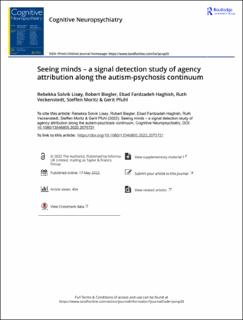| dc.contributor.author | Lisøy, Rebekka Solvik | |
| dc.contributor.author | Biegler, Robert | |
| dc.contributor.author | Ebad Fardzadeh, Haghish | |
| dc.contributor.author | Veckenstedt, Ruth | |
| dc.contributor.author | Moritz, Steffen | |
| dc.contributor.author | Pfuhl, Gerit | |
| dc.date.accessioned | 2022-11-28T13:29:54Z | |
| dc.date.available | 2022-11-28T13:29:54Z | |
| dc.date.created | 2022-05-20T08:31:01Z | |
| dc.date.issued | 2022 | |
| dc.identifier.citation | Cognitive Neuropsychiatry. 2022, 27(5), 356-372. | en_US |
| dc.identifier.issn | 1354-6805 | |
| dc.identifier.uri | https://hdl.handle.net/11250/3034510 | |
| dc.description.abstract | Introduction
Diametrically aberrant mentalising biases, namely hypermentalising in psychosis and hypomentalising in autism, are postulated by some theoretical models. To test this hypothesis, we measured psychotic-like experiences, autistic traits and mentalising biases in a visual chasing paradigm.
Methods
Participants from the general population (N = 300) and psychotic patients (N=26) judged the absence or presence of a chase during five-second long displays of seemingly randomly moving dots. Hypermentalising is seeing a chase where there is none, whereas hypomentalising is missing to see a chase.
Results
Psychotic-like experiences were associated with hypermentalising. Autistic traits were not associated with hypomentalising, but with a reduced ability to discriminate chasing from non-chasing trials. Given the high correlation (τ = .41) between autistic traits and psychotic-like experiences, we controlled for concomitant symptom severity on agency detection. We found that all but those with many autistic and psychotic traits showed hypomentalising, suggesting an additive effect of traits on mentalising. In the second study, we found no hypermentalising in patients with psychosis, who performed also similarly to a matched control group.
Conclusions
The results suggest that hypermentalising is a cognitive bias restricted to subclinical psychotic-like experiences. There was no support for a diametrically opposite mentalising bias along the autism-psychosis continuum. | en_US |
| dc.language.iso | eng | en_US |
| dc.publisher | Taylor and Francis Group | en_US |
| dc.rights | Attribution-NonCommercial-NoDerivatives 4.0 Internasjonal | * |
| dc.rights.uri | http://creativecommons.org/licenses/by-nc-nd/4.0/deed.no | * |
| dc.title | Seeing minds – a signal detection study of agency attribution along the autism-psychosis continuum | en_US |
| dc.title.alternative | Seeing minds – a signal detection study of agency attribution along the autism-psychosis continuum | en_US |
| dc.type | Peer reviewed | en_US |
| dc.type | Journal article | en_US |
| dc.description.version | publishedVersion | en_US |
| dc.source.journal | Cognitive Neuropsychiatry | en_US |
| dc.identifier.doi | 10.1080/13546805.2022.2075721 | |
| dc.identifier.cristin | 2025826 | |
| cristin.ispublished | true | |
| cristin.fulltext | original | |
| cristin.qualitycode | 1 | |

